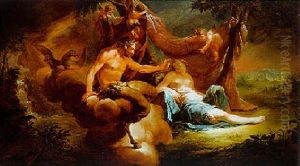Cosmas Damian Asam Paintings
Cosmas Damian Asam was a German painter and architect during the late Baroque period. Born on September 29, 1686, in Benediktbeuern, Bavaria, he was part of an artistically prolific family. His father, Hans Georg Asam, was a painter, and his younger brother, Egid Quirin Asam, was an equally notable sculptor and architect. Together, the Asam brothers are regarded as important figures of the Southern German Baroque, often collaborating on church commissions.
Cosmas Damian initially trained under his father and later continued his education at the Jesuit Gymnasium in Munich. His further artistic development took place in Rome, where he stayed from about 1711 to 1713. There, he was profoundly influenced by the grandeur of Italian Baroque and the works of artists like Gian Lorenzo Bernini and Pietro da Cortona. This experience was crucial in shaping his style, characterized by dramatic expressions, dynamic compositions, and a bold use of light and shadow.
Upon his return to Germany, Asam worked with his brother on numerous church projects, which often involved a close integration of architecture, painting, and sculpture to create immersive and emotive spaces designed to inspire awe and devotion. Cosmas Damian's role was often that of the principal painter, creating large frescoes that adorned the ceilings and walls. One of his most famous works is the ceiling fresco of the Abbey Church of Weingarten, which is one of the largest of its kind in the world.
The Asam brothers' partnership culminated in the creation of the Asam Church (St. Johann Nepomuk) in Munich, which is considered a masterpiece of Baroque art and architecture. Cosmas Damian not only painted the main fresco and altarpiece but also participated in the design of the building itself, blurring the lines between painter and architect.
Cosmas Damian Asam's career was prolific, with works spread across Southern Germany and parts of Austria. His legacy is marked by the profound impact he had on the development of the Rococo style that followed the Baroque. He died on May 10, 1739, in Munich, leaving behind a body of work that continues to be celebrated for its artistic vigor and its embodiment of the Baroque spirit.





